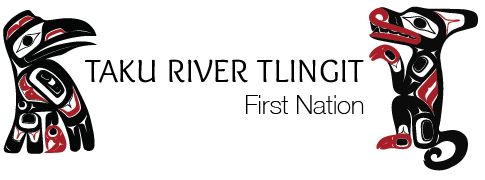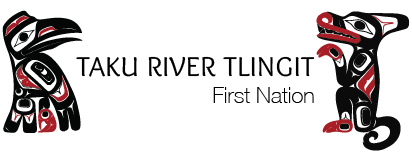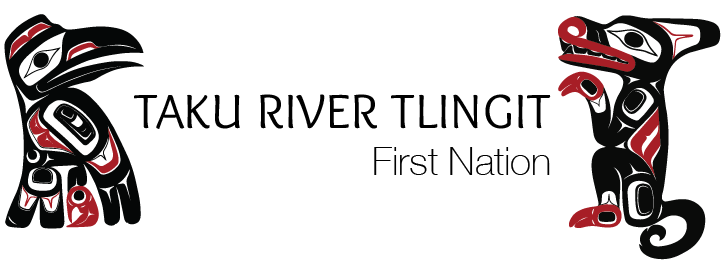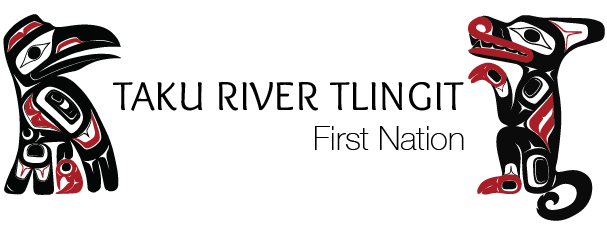Q&A: Taku River Tlingit First Nation
G2G Agreement with Yukon
September 15, 2022
Q: Why is TRTFN negotiating with Yukon?
Our negotiations with the Government of Yukon were required as the result of a court case.
TRTFN mounted a successful aboriginal rights infringement case against the Yukon, largely in
response to Yukon’s proposed development of a major campground at the north end of Atlin
Lake. In 2016, the courts made two declarations that compelled Yukon to consult and potentially
accommodate the TRTFN with respect to potential impacts of Yukon authorizations on TRTFN
rights and title interests in the Northern Territory. The proposal to develop the campground was
put on hold for five years, to allow TRTFN and Yukon time for negotiations.
Q: Will the Northern Territory negotiations result in a treaty?
No, or at least, not yet. At some point, the TRTFN might choose to negotiate a treaty settlement
in our Northern Territory, which would need to involve both Yukon and Canada. (In fact, there is
a trilateral negotiations table already in place but discussions are at an early stage).
The focus of the current bilateral negotiations with the Government of Yukon are not related to
treaty however, but instead result from the 2016 court case. Our current negotiations are
focused on developing a mutually acceptable approach for consultation and engagement, and
addressing the need for accommodation related to the infringement of our rights.
Q: What will the TRTFN-YG G2G Agreement actually do for us?
The TRTFN-YG G2G Agreement lays the foundation for a respectful, government-to government relationship and marks the beginning or a new chapter for the TRTFN North of 60°. The stated purposes of the agreement include taking “tangible steps forward on the journey of reconciliation, including establishing decision making arrangements…with the intent to secure the consent of the TRTFN.” The G2G Agreement is also a step towards recognition of the TRTFN as a First Nation with Aboriginal Rights in the Yukon Territory, and securing opportunities for TRTFN citizens to gain access to Yukon programs and opportunities.
Like all G2G agreements, the completion of negotiations is just the beginning. The implementation of the agreement is where many of the benefits and opportunities will be
realized.
Q: How does the TRTFN-YG G2G Agreement compare to the existing agreement with BC?
The two agreements are similar but the TRTFN-YG G2G Agreement includes some modest
upgrades based on our experience with BC over the past 10+ years.
The TRTFN NT negotiating team was directed by our Leaders to seek an agreement that was
similar or better than the Wóoshtin Yan Too.Aat Land and Resource Management and Shared
Decision Making Agreement (2011). The draft TRTFN-YG G2G Agreement includes similar
elements as the BC agreement, such as a bilateral, TRTFN-YG Northern Territory G2G Forum,
a structured consultation and engagement process for review of development applications, and
a series of collaborative joint initiatives. Some of the upgrades include (i) an arrangement for
regular meetings of TRTFN and YG senior political representatives, (ii) a secretariat to support
the work of the NT G2G Forum, (iii) improvements in the consultation and engagement process
that provide more opportunities for TRTFN to influence YG decisions on development
applications, and (iv) a separate consultation and engagement process for other topics such as
changes to legislation, or approval of management plans.
Q: How much time and effort will be needed to implement the TRTFNYG G2G Agreement?
The TRTFN-YG G2G Agreement includes a commitment for the YG to provide funding to
support implementation efforts (as a grant, not a loan). The NT G2G Forum is expected to meet
several times per year, perhaps with meetings scheduled to align closely with similar meetings
with BC. Given the low level of development activities in the Northern Territory (only ~3
applications/year over the past decade), implementation of the consultation and engagement
process is expected to be relatively straightforward, with steps and timelines similar to those
used for BC. The joint initiatives will require time and effort from TRTFN departments, but it is
hoped that the funding provided under the agreement will be adequate to cover that time.
Q: Implementation of the TRTFN-BC G2G Agreement has been challenging at times. Why would we create something similar with
YG?
A recent evaluation of the TRTFN-BC G2G Agreement (2021) highlighted both successes and
shortcomings over the past 10 years. Some things have worked well and have resulted in
improved working relationships, better collaboration on technical issues, and a willingness from
BC and the TRTFN to find creative solutions. At the same time, the implementation of the
TRTFN-BC Agreement has not been perfect and BC has fallen short in some key areas, such
as the designation of protected areas in the southern Taku.
The TRTFN-YG G2G Agreement offers opportunities to improve the relationship with the
Government of Yukon, which is currently at a much earlier stage than our relationship with BC.
The TRTFN-YG G2G Agreement will also allow us to strengthen our authority in the Northern
Territory. It is an incremental step forward, however, not the end of the story. As has been the
case in BC, many of the benefits of a G2G relationship will only be realized through
implementation over time and will require hard work. The JCM will ultimately need to decide
whether the TRTFN-YG G2G Agreement offers more benefits and opportunities than the status
quo.
Q: What are risks? What are we giving up?
There are no significant risks involved in completing the TRTFN-YG G2G Agreement: the
agreement does not in any way undermine our Aboriginal rights and title; it has nothing to do
with the Umbrella Final Agreement; and, it has no impact on a potential treaty settlement in the
future. It is a first step toward a different kind of relationship with the Yukon Government, which
helps to reduce risks for the future.
Completing the TRTFN-YG G2G Agreement will however mean that the TRTFN is willing to
‘retire the 2016 litigation’—in other words, accept the new arrangements under the G2G
Agreement and the accommodation that is available through the Áashú Land Transfer
Agreement—in return for resolving the legal dispute we have had with the Yukon Government
over their past infringement of Aboriginal rights.
Q: Can we cancel the TRTFN-YG Agreement if it isn’t working?
Yes. The TRTFN-G2G Agreement includes a mechanism for termination—by either TRTFN or
YG—with 90 days written notice. However, the agreement does require both governments to try
to resolve any disputes prior to terminating the agreement, which might involve arranging for a
meeting of senior political representatives, or using a dispute resolution process which is set out
in the agreement itself, or both.
Q: Has our legal counsel reviewed the draft TRTFN-YG G2G Agreement?
Yes. The TRTFN legal counsel has been involved at multiple stages as the negotiations have
been underway, and has completed a complete and thorough review of the document.
Comments from our legal counsel will be available at the JCM. Áashú Land Transfer Agreement
Q: What is the Áashú Land Transfer Agreement
The Áashú Land Transfer Agreement, or LTA, is an agreement between the Yukon Government
and TRTFN that will result in the transfer to the TRTFN of an 1,100 hectare parcel of land at the
north end of Atlin Lake, called the “Áashú Lands.” These lands will be held by TRTFN in “fee
simple” or as private lands, for the long term use and benefit of the TRTFN community. This will
be the largest fee simple transfer in the history of the Yukon. (By way of a comparison, he
Áashú Lands are about 25% larger than the 5 Mile Reserve).
Q: Where are the Áashú Lands?
The Áashú Lands extend from the BC-Yukon border north along the Atlin Rd past Anderson
Point. The parcel includes the shoreline of Atlin Lake to the Lubock River, and then along the
Lubock River to the northern boundary of the parcel. The following map shows the Áashú
Lands.
Q: Why is the Yukon Government transferring these lands to TRTFN?
The TRTFN won an important court case against the Yukon Government in 2016, stemming
from Yukon’s proposal to develop a major new campground on the Áashú Lands. The transfer
of these lands are part of the accommodation by Yukon stemming from that court case.
The land transfer is one step in the long process of reconciliation between the Yukon
Government and TRTFN for the failure of the Yukon government to recognize TRTFN’s
aboriginal rights and title in the Yukon.
Through this agreement—and the parallel Northern Territory Government to Government
Agreement—Yukon will have met its obligations under the Taku River Tlingit First Nation v
Yukon, YKSC S.C. No.13-A0147. In part, Yukon is transferring the lands in order to
have TRTFN agree to retire the outstanding litigation.
Q: Are we giving up our rights and title to get the Áashú Lands?
No. The Áashú LTA is not a land claim agreement and does not in any way define, limit, or
constrain TRTFN’s aboriginal rights and title in the Northern Territory.
Q: Why aren’t we getting the Áashú Lands as Treaty Settlement Lands
or Reserve?
The transfer of the Áashú Lands to TRTFN in ‘fee simple”, or private land, stems from the
bilateral negotiations with Yukon and the court case. Yukon does not have the unilateral
jurisdiction to create Indian Act Reserves or establish treaty settlement lands.
We are engaging with Canada and Yukon at our transboundary land claim table. Depending on
the TRTFN community’s wishes, the Áashú Lands might—at some point in the future—become
either Treaty Settlement Lands under a northern land claim agreement, or a new Reserve by
agreement with Canada and the Yukon through those trilateral discussions.
Q: How will we be able to use the Áashú Lands?
The Áashú Lands will be used primarily for TRTFN community purposes, which may include use
and development opportunities such as camps and infrastructure to support traditional uses;
community housing; social-enterprise opportunities to benefit TRTFN members; and ecotourism and cultural based tourism.
An Áashú Revitalization Plan will be developed with extensive community involvement and
input once the land is held by TRTFN.
Q: Will other people be able to use the Áashú Lands?
The general public will be able to cross the Áashú Lands on two defined access routes – the
Northern Access Road to the Lubock River from the Atlin Road, and the Southern Access Road
to the Atlin Lake waterfront from the Yukon Camp turnoff.
The general public will also be able to use the waterfront (defined as 100 ft, or 30.42 metres,
from the high water mark of Atlin Lake) for temporary use, such as landing a boat, hiking along
the shoreline, and overnight camping, but not for longer term use.
The general public will not be able to access or use the remainder of the Áashú Lands without
TRTFN permission.
TRTFN will allow the holders of the Trapline to access Áashú Lands for the purpose of
trapping, but the Trapline holder will not be able to trap within 1 km of any structure, and cannot
build any structure without TRTFN permission.
TRTFN will also enter into a Partnership Agreement with Skookum Jim Friendship Centre
(SJFC) to allow SJFC to conduct on-the-land programming on the Áashú Lands, subject to
agreement with TRTFN.
Q: Who will make decisions about how the Áashú Lands are used?
The Áashú Lands will need to be held by a TRTN corporation to limit liability and maximize the
tax advantages for the TRTFN and community. The Northern Territory negotiating team is
currently seeking legal advice on the best structure, but it is likely that a new TRTFN Limited
Partnership will be created in the Yukon to hold the property on behalf of the TRTFN
community. We anticipate conducting an intensive community process to canvass people’s
views and interests for the long term development and use of the property, and the results of
that community process will guide the future use and development of the property.
Q: How much will it cost to own the Áashú Lands?
Yukon has agreed to reimburse TRTFN for the base property tax for a period of ten years. The
base tax for the Áashú Lands is a modest amount of approximately $375/year.
If significant “improvements” are made on the Áashú Lands, those developments would be
subject to tax, but taxable improvements do not include infrastructure and development
relegated to traditional and cultural use such as camps, cabins and cultural facilities.
Q: Will TRT own all the existing private land parcels at the north end
of Atlin Lake?
There are three private land parcels that are not included in the Áashú Lands. This includes
Camp Yukon (22 ha) and two smaller private land parcels (5.4 ha, and 1 ha). These property
owners will continue to own these properties and be able to use their private lands and access
their properties along the public highways through the Áashú Lands as described above.





